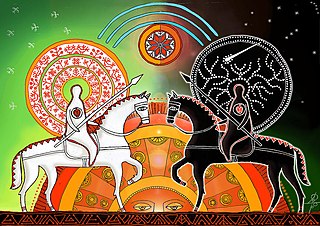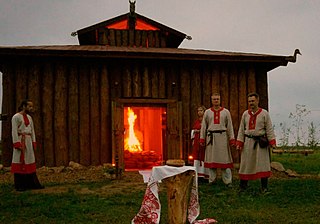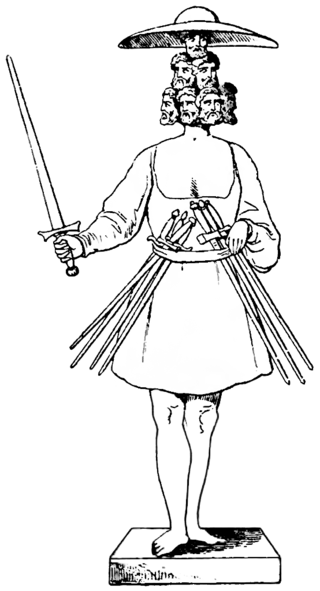
Chernobog and Belobog are an alleged pair of Polabian deities. Chernobog appears in Helmold's Chronicle as a god of misfortune worshipped by the Wagri and Obodrites, while Belobog is not mentioned – he was reconstructed in opposition to Chernobog. Both gods also appear in later sources, but they are not considered reliable. Researchers do not agree on the status of Chernobog and Belobog: many scholars recognize the authenticity of these theonyms and explain them, for example, as gods of good and evil; on the other hand, many scholars believe that they are pseudo-deities, and Chernobog may have originally meant "bad fate", and later associated with the Christian devil.

Stribog is a god in Slavic mythology found in three East Slavic sources, whose cult may also have existed in Poland. The sources do not inform about the functions of the god, but nowadays he is most often interpreted as a wind deity who distributes wealth.

Svarog is a Slavic god of fire and blacksmithing, who was once interpreted as a sky god on the basis of an etymology rejected by modern scholarship. He is mentioned in only one source, the Primary Chronicle, which is problematic in interpretation. He is presented there as the Slavic equivalent of the Greek god Hephaestus. The meaning of his name is associated with fire. He is the father of Dazhbog and Svarozhits.

Svetovit, Sventovit, Svantovit is the god of abundance and war, and the chief god of the Slavic tribe of the Rani, and later of all the Polabian Slavs. His organized cult was located on the island of Rügen, at Cape Arkona, where his main temple was also located. According to the descriptions of medieval chroniclers, the statue representing this god had four heads, a horn and a sword, and to the deity himself were dedicated a white horse, a saddle, a bit, a flag, and eagles. Once a year, after the harvest, a large festival was held in his honor. With the help of a horn and a horse belonging to the god, the priests carried out divinations, and at night the god himself rode a horse to fight his enemies. His name can be translated as "Strong Lord" or "Holy Lord". In the past it was often mistakenly believed that the cult of Svetovit originated from St. Vitus. Among scholars of Slavic mythology, Svetovit is often regarded as a Polabian hypostasis of Pan-Slavic god Perun. His cult was destroyed in 1168.

Triglav was the chief god of the Pomeranian and probably some of the Polabian Slavs, worshipped in Szczecin, Wolin and probably Brenna. His cult is attested in several biographies of the bishop St. Otto of Bamberg in the years immediately preceding his suppression of it in 1127.

In the pre-Christian religion of Eastern and Southern Slavs, Rod is the god of the family, ancestors and fate, perhaps as the supreme god. Among Southern Slavs, he is also known as Sud. He is usually mentioned together with Rozhanitsy deities. One's first haircut (postriziny) was dedicated to him, in a celebration in which he and the rozhanitsy were given a meal and the cut hair. His cult lost its importance through time, and in the ninth or tenth century he was replaced by Perun, Svarog and/or Svetevid, which explains his absence in the pantheon of Vladimir the Great.

Khors is a Slavic god of uncertain functions mentioned since the 12th century. Generally interpreted as a sun god, sometimes as a moon god. The meaning of the theonym is also unknown: most often his name has been combined with the Iranian word for sun, such as the Persian xoršid, or the Ossetian xor, but modern linguists strongly criticize such an etymology, and other native etymologies are proposed instead.

Porenut is a god with unknown functions mentioned in only two sources: Gesta Danorum and in Knýtlinga saga. The only historical information about this god is the description of a statue depicting him with four faces on his head and a fifth face on his chest, which was held by his chin with his right hand and his forehead with his left hand.

Radegast or Radogost is, according to medieval chroniclers, the god of the Polabian Slavs, whose temple was located in Rethra. In modern scientific literature, however, the dominant view is that Radegast is a local nickname or a local alternative name of the solar god Svarozhits, who, according to earlier sources, was the chief god of Rethra. Some researchers also believe that the name of the town, where Svarozhits was the main deity, was mistakenly taken for a theonym. A popular local legend in the Czech Republic is related to Radegast.

Yarovit, Iarovit is a Polabian god of war, worshipped in Vologošč (Circipanians) and Hobolin. Sources give only a brief description of his cult, his main temple was located in Vologošč, where there was a golden shield belonging to Yarovit. By one Christian monk he was identified with the Roman Mars.
Rozhanitsy, narecnitsy, and sudzhenitsy are invisible spirits or deities of fate in the pre-Christian religion of the Slavs. They are related to pregnancy, motherhood, marriage and female ancestors, and are often referenced together with Rod. They are usually mentioned as three together, but sometimes up to 9 together, of whom one was a "queen" or singular. They are related to Dola, but it is not known on what terms. In Poland they were worshipped as zorze (auroras).
Jesza or Jasza is an alleged Polish god. He was first mentioned around 1405-1412 in the sermons of Lucas of Wielki Koźmin, which warned against the worship of Jesza and other gods during spring rituals and folk performances. His popularity is partly owed Jan Długosz's comparison of him to the Roman god Jupiter. However, the opinions of the 20th century and later researchers are divided with respect to the authenticity of the deity.
Chernoglav or Chernoglov is the god of victory and war worshipped in Rügen, probably in the town of Jasmund, mentioned together with Svetovit, Rugievit, Turupid, Puruvit and Pizamar in the Knýtlinga saga.
The fifth god was called Pizamar from a place called Jasmund, and was destroyed by fire, There was also Tjarnaglófi, their god of victory who went with them on military campaigns. He had a moustache of silver and resisted longer than the others but they managed to get him there years later. Altogether, they christened five thousand on this expedition.
Pereplut is a Slavic deity or a demon with an unclear function. It appears in the list of gods and demons of the 12th-century Ruthenian interpolation of the Word of St. Grigory, as well as in the Word of St. John. According to the source account, pagan Slavs worshiped :
Vila, Mokosh, Dziwa, Perun, Khors, Rod and Rozhanitsy, ghosts and banks, and Pereplut, and turning to drink to him in the corners

Svarozhits, Svarozhich is a Slavic god of fire, son of Svarog. One of the few Pan-Slavic gods. He is most likely identical with Radegast, less often identified with Dazhbog.

Rugiaevit, Rugievit or Ruyevit is a god of the Slavic Rani worshipped on Rügen, mentioned in only two sources: Gesta Danorum and in Knýtlinga saga. His temple, along with those of Porevit and Porenut, was located in the gord of Charenza, probably today's Garz. The statue of him had seven faces, seven swords at his belt and an eighth one in his hand. Under his lips was a nest of swallows. Mostly associated with the sphere of war, but also sexual.
Porevit, Porovit or Borovit is a Slavic god with unknown functions mentioned in only two sources: Gesta Danorum and in Knýtlinga saga. The only historical information about this god is a description of a statue depicting him that had five faces and no weapons.

A zhrets is a priest in the Slavic religion whose name is reconstructed to mean "one who makes sacrifices". The name appears mainly in the East and South Slavic vocabulary, while in the West Slavs it is attested only in Polish. Most information about the Slavic priesthood comes from Latin texts about the paganism of the Polabian Slavs. The descriptions show that they were engaged in offering sacrifices to the gods, divination and determining the dates of festivals. They possessed cosmological knowledge and were a major source of resistance against Christianity.

Hennil or Bendil is an alleged agrarian Slavic god worshipped by the Polabian Slavs. He was mentioned by Bishop Thietmar in his Chronicle as a god who was represented by a staff crowned by a hand holding a ring, which is interpreted as a symbol of fertility. However, there is no general consensus on the authenticity of the deity.




































